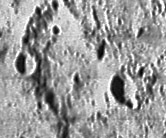Seneca
Contents
Seneca
|
Lat: 26.6°N, Long: 80.2°E, Diam: 46 km, Depth: km, Rükl: 27 |
Table of Contents
[#Seneca Seneca]
[#Seneca-Images Images]
[#Seneca-Maps Maps]
[#Seneca-Description Description]
[#Seneca-Description: Elger Description: Elger]
[#Seneca-Description: Wikipedia Description: Wikipedia]
[#Seneca-Additional Information Additional Information]
[#Seneca-Nomenclature Nomenclature]
[#Seneca-LPOD Articles LPOD Articles]
[#Seneca-Bibliography Bibliography]

LOIV-165-H3 Seneca is the large, squarish crater in the center. The larger part of the keyhole shape in the lower right is Seneca D.
Images
LPOD Photo Gallery Lunar Orbiter Images Apollo Images
Maps
(LAC zone 45B4) USGS Digital Atlas PDF
Description
Description: Elger
(IAU Directions) SENECA.--Rather smaller than Plutarch. Too near the limb for satisfactory observation. Schmidt shows two considerable mountains in the interior. The position of this object in Schmidt's chart is not accordant with its place in Beer and Madler's map, nor in that of Neison.
Description: Wikipedia
Additional Information
Nomenclature
- Named for Lucius Annaeus Seneca (4 B.C.- A.D. 65), a Roman philosopher and natural scientist.
- As noted by Elger, there was considerable confusion about the intended identity of this feature on the classic Moon maps.
- Seneca is listed as catalog entry 137 in Mary Blagg's Collated List (1913). Blagg interpreted Schmidt's map as labeling this entry "Plutarchus", while using the name Senecea for a feature east of Hahn that was to enter the IAU nomenclature as catalog entry 137A = Timoleon. She felt both Neison and Beer and Mädler had used "Seneca" for entry 137.
- Catalog entry 137 (Seneca) in Named Lunar Formations was assigned a position of 29.5ºN, 81.3ºE and a diameter of 43 km, with the name being attributed to Riccioli. This corresponds to a position between the modern Seneca E and F. Although there is no distinct crater at this location, at Full Moon it appears as a definite dark spot, similar to Hahn.
- Johann Schröter thought Riccioli's Seneca was the modern Berosus (see Plutarch).
- Gerard Kuiper, in Table III of his Photographic Lunar Atlas, expressed his opinion that the IAU's Seneca differed from that of the "original authority" (which he identifies as Mädler) and moved the name to its present location. His changes were approved by the IAU in 1961.
LPOD Articles
Bibliography
This page has been edited 1 times. The last modification was made by - tychocrater tychocrater on Jun 13, 2009 3:24 pm - afx4